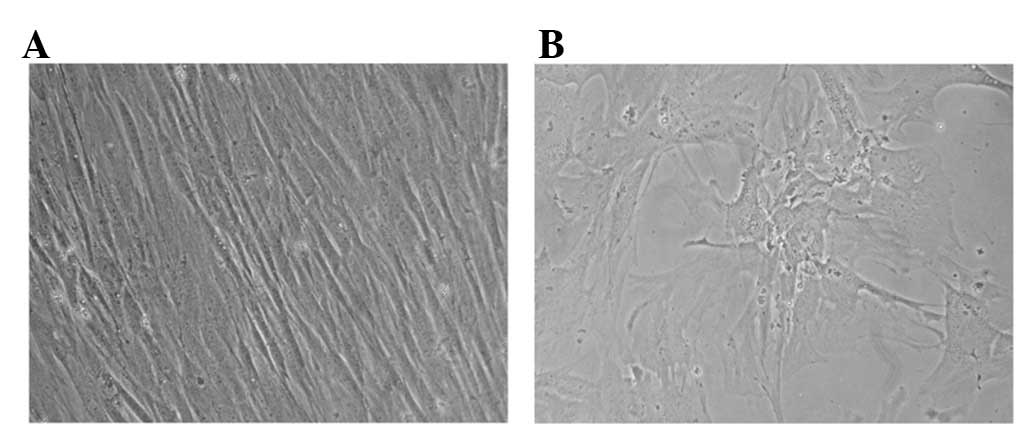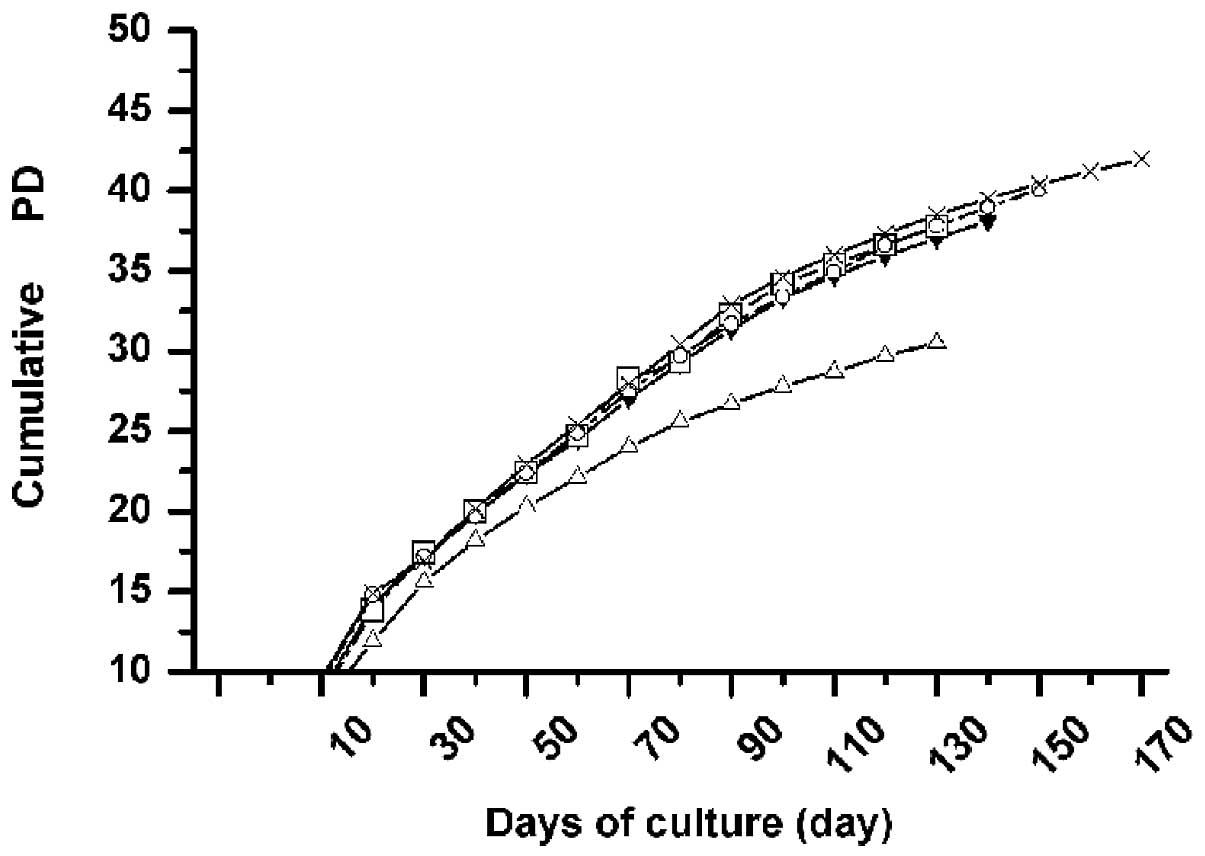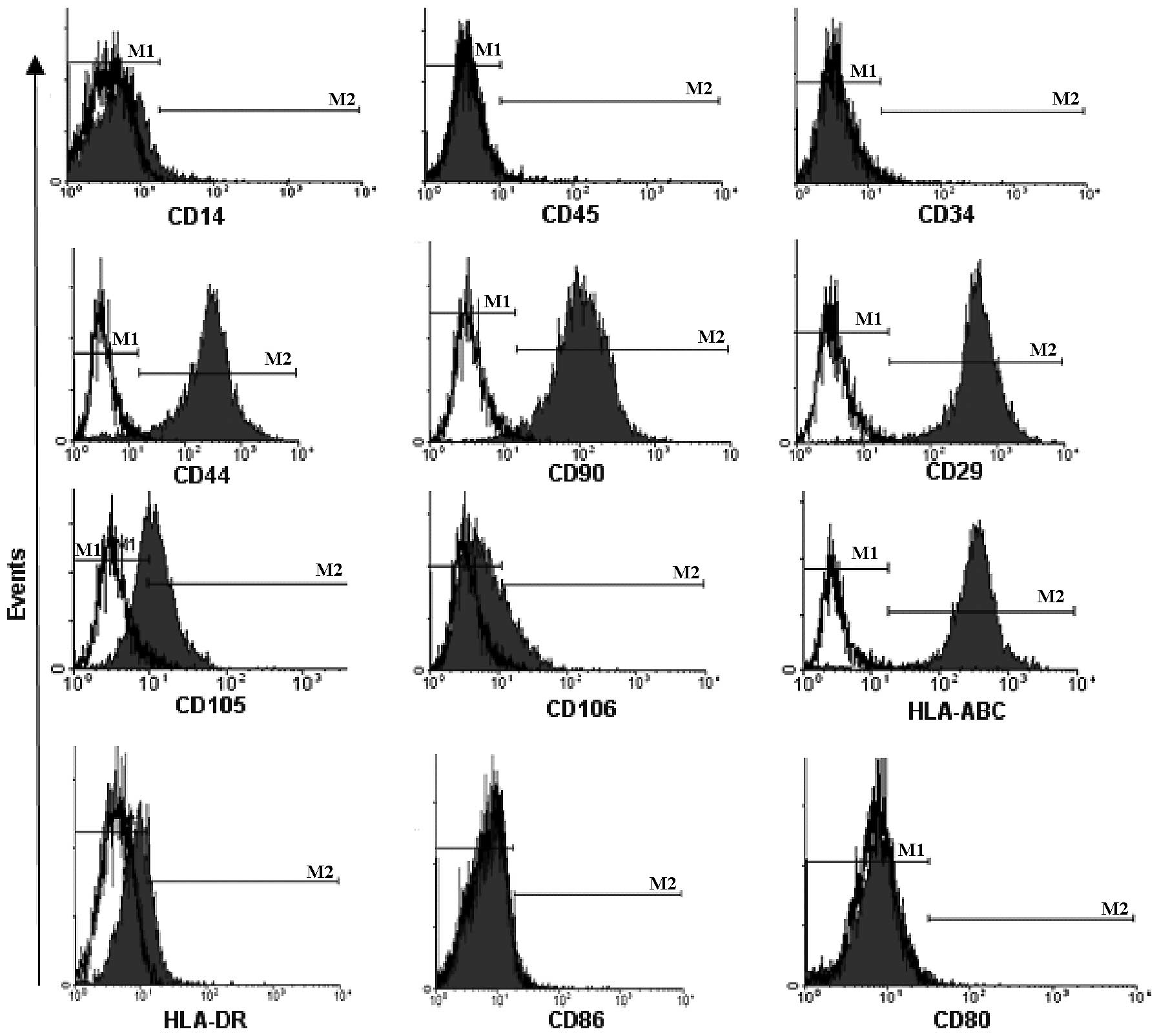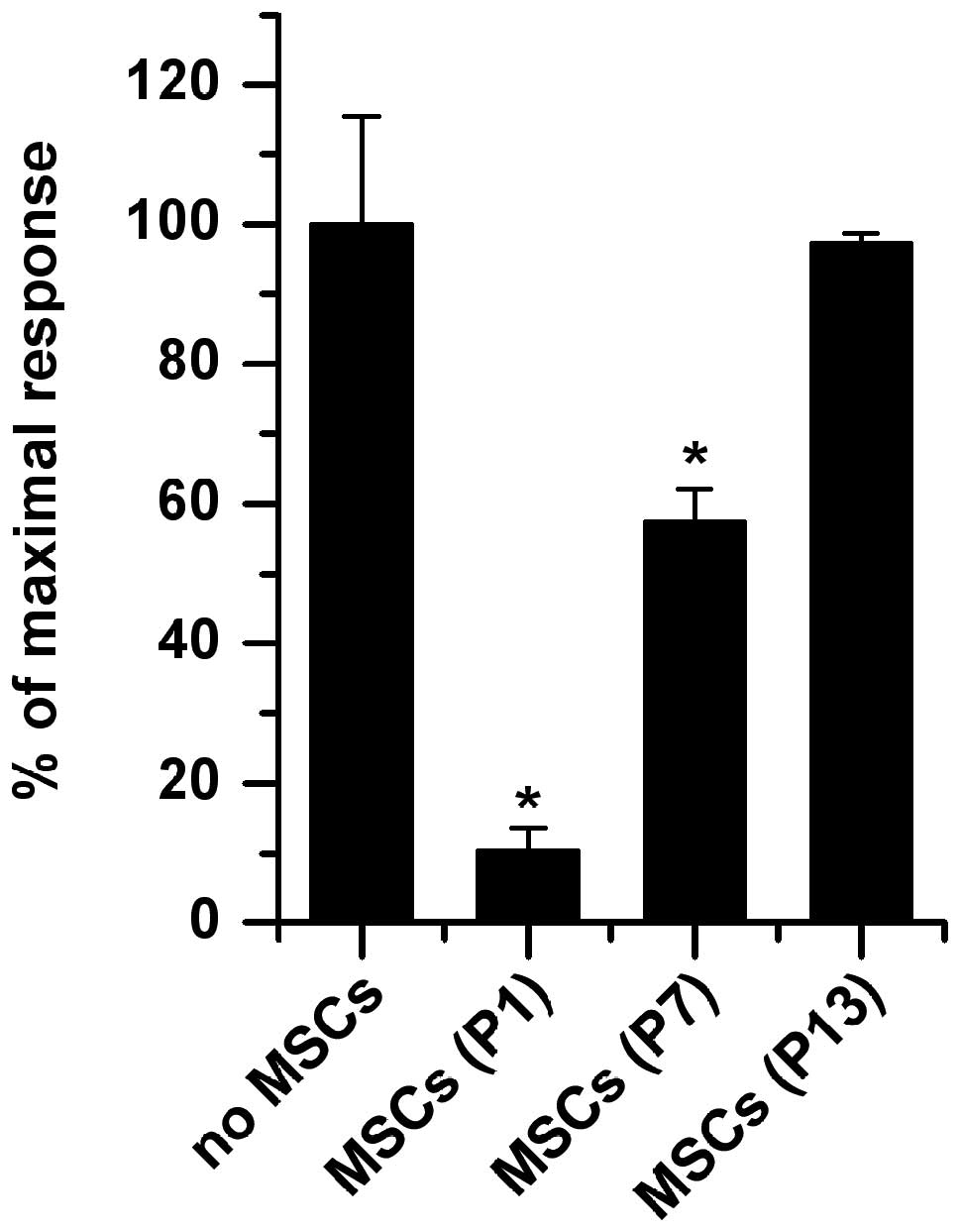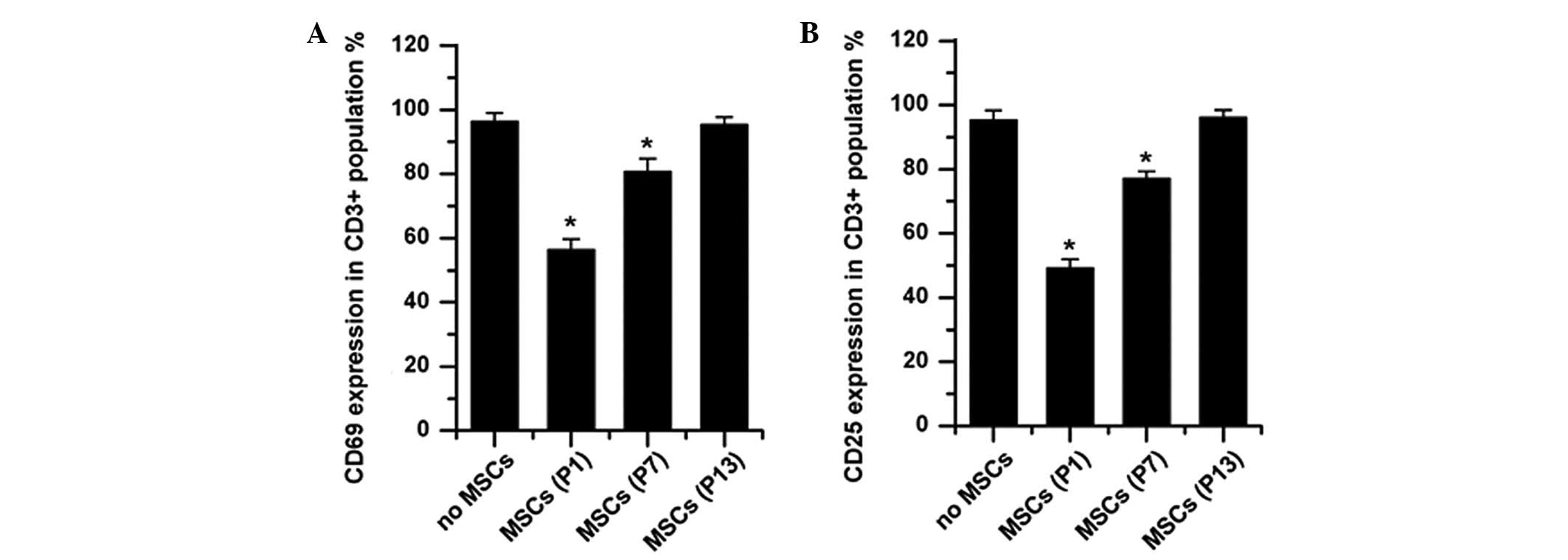Long-term culture in vitro impairs the immunosuppressive activity of mesenchymal stem cells on T cells
- Authors:
- Published online on: August 17, 2012 https://doi.org/10.3892/mmr.2012.1039
- Pages: 1183-1189
Abstract
Introduction
Bone marrow stromal stem cells or mesenchymal stem cells (MSCs) have been under intense scrutiny for many years (1–3). In addition to the multilineage potential of MSCs in vitro and in vivo(3–6), further interest in the clinical application of MSCs has been raised in recent years by the observation that MSCs are capable of exerting a profound immunosuppressive ability (7–9). Injections of MSCs have been reported to successfully prolong the survival of mismatched skin grafts in animals (10) and have also been proven to be of therapeutic use in graft-versus-host disease (GVHD) treatment in clinical trials (11). On the basis of these findings, some researchers employed MSCs to treat experimental autoimmune encephalomyelitis (EAE) and successfully alleviated this T-cell-mediated autoimmune disease in an animal model (12). Furthermore, our group recently demonstrated that MSCs could exert profound suppressive effects on type II collagen-reactive T cells from rheumatoid arthritis (RA) patients (13). Improved knowledge of these immunological properties of MSCs creates a potential cell-immunotherapeutic approach for arthritic diseases, and MSCs have also been gaining attention from rheumatologists (14).
Although the potential of MSCs in therapy is encouraging, the low frequency of MSCs in bone marrow necessitates their in vitro expansion prior to clinical use. In recent years, long-term culture and sequential passages in vitro by adherence to plastic has been used as the most popular strategy for MSC isolation, purification and expansion (3,4). However, potential difficulties are the subtle changes these cells undergo as they are expanded in culture. A previous study has proven that the telomere length of MSCs shortens after each division cycle (15), which leads to a gradual senescence of MSCs. Some researchers believe that MSCs enter senescence almost undetectably from the moment of culture in vitro(16). Despite the premature aging of stem cells that has been reported, which may have implications for other cell lineages and may provide the basis for immune-mediated tissue damage and the breakdown of self-tolerance (17), our understanding of the effects of in vitro amplification on the immunological properties of MSCs, which is critical to future cell-therapeutic applications, remains in its infancy.
With this in mind, in the present study we characterized the changes of morphology, immunophenotype, growth rate and the biological characteristics of MSCs during expansion in vitro; we further evaluated the effects of MSCs separated from different passages (designated as P1, P7 and P13, respectively) on the proliferation, activation and cytokine production of allogenic T cells.
Materials and methods
Isolation and long-term culture of human MSCs
Bone marrow aspirates (10 ml) were obtained from the iliac crests of 5 healthy donors (3 males and 2 females, aged 20–30 years). The procedure was approved by the Ethics Committee at Xijing Hospital, and the donors provided informed consent. The widely used method of MSC culture, which was firstly adopted 10 years ago (3) and was used in a recent published study (18), was also adopted in the current study. Briefly, mononuclear cells were isolated from Percoll-separated bone marrow and resuspended in medium consisting of Dulbecco’s modified Eagle’s medium-low glucose (DMEM-LG; Gibco-BRL, Carlsbad, CA, USA), supplemented with 10% fetal bovine serum (FBS; Hyclone, Logan, UT, USA). Mononuclear cells were plated at 2×107 cells/cm2 in 75 cm2 flasks (Corning, Acton, MA, USA) for primary culture, and the culture was maintained at 37°C in a humidified atmosphere containing 5% CO2. Cells were fed by completely replacing the medium every 3 days. When fibroblast-like cells at the base of the flask reached more than 90% confluence, the cells were trypsinized in trypsin-EDTA (Gibco-BRL, Denmark), and reseeded at 5×103 cells/cm2 in 75 cm2 flasks. On reaching confluence, all cultures were passaged sequentially until the cells reached their maximal life span, as evidenced by growth arrest where the cells failed to become confluent within 4 weeks of culturing (19). After every 6th passage, some of the expanded cells were separated for studying. The adherent cells derived from the 5 donors were all identified as MSCs according to the method described in our previous report (13).
Characterization of morphology of long-term cultured MSCs
To study the morphological characteristics of long-term cultured MSCs, cell culture flasks were observed at every medium re-feeding interval to detect any abnormalities in cell morphology and medium. When any variation was observed, the changes were recorded.
Quantification of MSC growth in long-term culture
To determine the number of cumulative population doublings (PD), MSCs were trypsinized, counted and reseeded at a density of 5×103/cm2 in 75 cm2 flasks during sequential passages following primary culture. Cell growth was monitored by determining the number of PDs using the following formula: Log N/log 2, where N is the cell number of the confluent monolayer divided by the initial number of cells seeded.
Assessment of senescence-associated β-galactosidase staining in long-term culture
Senescence-associated β-galactosidase (SA β-gal) staining was performed as described previously (20). MSCs separated from different passages (P1, P7 and P13, respectively) were seeded on slides (5×104 cells/cm2) and cultured to 90% confluence. They were washed in phosphate-buffered saline (PBS), fixed for 3–5 min at room temperature in 2% formaldehyde/0.2% glutaraldehyde (or 3% formaldehyde), and incubated overnight at 37°C (without CO2) with fresh SA β-gal staining solution (1 mg/ml 5-bromo-4-chloro-3-indolyl β-D-galactoside, 40 mM citric acid/sodium phosphate, pH 6.0, 5 mM potassium ferrocyanide, 5 mM potassium ferricyanide, 150 mM NaCl and 2 mM MgCl2). Staining was evident in 2–4 h and maximal in 12–16 h.
Determination of the immunophenotype of long-term cultured MSCs
Multiple surface markers were determined on MSCs at different stages during the long-term culture (P1, P7 and P13, respectively). The monoclonal antibodies used were anti-CD44 fluorescein isothiocyanate (FITC), anti-CD90 FITC, anti-CD105 FITC, anti-CD106 FITC, anti-HLA-ABC FITC, anti-HLA-DR FITC, anti-CD29 phycoerythrin (PE), anti-CD34 PE, anti-CD80 PE, anti-CD86 PE, anti-CD14 peridinin chlorophyll protein (Percp) and anti-CD45 Percp (all from Pharmingen, San Diego, CA, USA). Relevant isotope control antibodies were also used. Flow cytometry was performed on a FACScan (Becton Dickinson, ,Franklin Lakes, NJ, USA), and data were analyzed using Cellquest software.
Isolation of allogenic T cells
Heparinized peripheral blood (PB) was collected from 5 healthy donors (3 males and 2 females, aged 19–31 years) under sterile conditions with the approval of the Ethics Committee at Xijing Hospital and diluted 1:1 with DMEM-LG. Informed consent was obtained from all 5 donors prior to the study. Mononuclear cells in PB (PBMCs) were isolated by density gradient centrifugation on Ficoll-Hypaque (1.077 g/ml). Cell viability was 95% by trypan blue exclusion. PBMCs were then separated immunomagnetically into T cells and non-T cells using anti-CD3 microbeads (Miltenyi Biotec, Auburn, CA, USA). Non-T cells were used as antigen-presenting cells (APCs).
Proliferation assay
Non-T cells and MSCs (from P1, P7 and P13, respectively) were all irradiated (30 Gy) prior to being cultured with T lymphocytes. Each culture was performed in triplicate at 1×105 cells/well for T cells in 96-well round-bottomed microtiter plates (Corning) in a total volume of 0.2 ml DMEM-LG supplemented with 10% FBS. Non-T cells, acting as APCs, were mixed with T-cells at a ratio of 1:1. MSCs separated from different passages were then added to the plates at a ratio of 1:1 to T cells with the stimulation of phytohemagglutinin (PHA; 20 ng/ml; Sigma, St. Louis, MO, USA). T cells cultured only with non-T cells in the presence of PHA served as controls. The plates were incubated in a humidified atmosphere of 5% CO2 at 37°C for 3 days. Twelve hours prior to the end of culture, 1 μCi 3H-thymidine (NEN Life Science Products, Boston, MA, USA) was added to each well. Cells were harvested onto glass-fiber filter paper, dried and the incorporated 3H-thymidine was analyzed using a liquid scintillation counter. Data were expressed as median counts per minute (cpm) of triplicate samples. The inhibition capacity was calculated using the following formula: [1-(proliferation of PHA-stimulated T cells in the presence of MSCs) (cpm)/(proliferation of T cells stimulated with PHA alone) (cpm)] ×100%.
Activation assay
T cell activation assays were performed in 24-well round-bottomed plates (Corning) in a total volume of 1 ml DMEM-LG in triplicate. T cells were mixed at a 1:1 ratio with MSCs (from P1, P7 and P13, respectively) at a density of 1×106/well. Activation markers were stained on day 1 (for CD3/CD69, Pharmingen) and day 3 (for CD3/CD25, Pharmingen). The cells were then analyzed by flow cytometry.
Cytokine quantification
After 3 days of co-culture (ratios of MSCs to T cells, 1:1), with or without PHA stimulation, fresh supernatants were collected. Quantitative analyses of IL-10, IFN-γ and TNF-α production were performed by enzyme-linked immunosorbent assay (ELISA) using commercially available kits (R&D Systems, Minneapolis, MN, USA). Supernatants of MSCs (from P1, P7 and P13, respectively) and T cells that were cultured alone served as controls. The detection limits were 15 pg/ml for IL-10, 4 pg/ml for IFN-γ and 7 pg/ml for TNF-α, respectively.
Statistics
Results were expressed as the means ± SD of the mean. Differences between experimental conditions were analyzed by t-test (paired when possible). P<0.05 was considered to indicate a statistically significant difference.
Results
Morphological characterization of MSCs in long-term culture
MSCs were successfully isolated and expanded from all the 5 donors. After approximately 10 days of primary incubation, marrow-derived cells that adhered to the flasks gradually formed a confluent heterogeneous stromal cell layer and appeared microscopically to be a relatively homogeneous population of fibroblast-like cells after the first passage (P1,Fig. 1A).
However, MSCs increased in size and shape with a long period of conventional expansion in vitro, and showed abnormalities typical of the Hayflick model of cellular aging. Moreover, increasing numbers of non-attached floating MSCs were also consistently observed in prolonged passage. On average, granules were gradually noted in the cytoplasm of MSCs after P7, and debris formation was observed in medium of culture after approximately P10 of primary culture (data not shown). Particularly in later stages (around P13 in some cultures), MSCs lost their fibroblast-like morphology and began to be vacuolated, and finally detached from the base of the flasks (Fig. 1B).
Growth kinetics of MSCs in long-term culture
Starting from the primary passage, we analyzed the kinetics of growth of MSCs from all 5 donors, with respect to the passage number in multiple donors. In all donors tested, MSCs were expanded over at least 13 passages (range from P13 to P17, mean P14.4), with similar growth kinetics. The average time of culture was approximately 142 days (range, 130–170 days) until reaching their maximal life span, and the average number of cumulative PDs was approximately 37.7 (range, 30–42) in these days. The curve relationship between cumulative PD and the duration of culture demonstrates a relatively linear decreasing PD rate with the progression of time. Furthermore, an appreciable decrease in the number of PD was observed in the late days of culture (>100 days in culture; Fig. 2), indicating that the proliferative potential of MSCs decreased with long-term culture in vitro.
Cellular senescence markers expressed on MSCs in long-term culture
An increase in the number of cells staining positive for SA β-gal was observed in the long-term in vitro culture. As shown in Fig. 3, early-passage MSCs (P1) only contained 2±0.4% positive cells, while the proportion of positive cells significantly increased to 16±3% in P7 (16±3 vs. 2±0.4%, P<0.001). When MSCs were passaged to P10, the cells displaying detectable SA β-gal activity reached up to 35±2% (35±2 vs. 2±0.4%, P<0.001; 35±2 vs. 16±3%, P<0.001), demonstrating that MSCs would be senescent during the long-term expansion in vitro. MSCs from all 5 donors showed similar results in the long-term culture.
Immunophenotype of MSCs in long-term culture
We employed multiple monoclonal antibodies to detect the immunophenotype of MSCs from P1, P7 and P13 to investigate the effects of long-term culture on the immunophenotype of MSCs. As Fig. 4 shows, MSCs from P1 were uniformly positive for the expression of CD29, CD44, CD90, CD105, CD106 and HLA-ABC, but negative for the expression of CD14, CD34, CD45, CD80, CD86 and HLA-DR. These immunophenotypes expressed on MSCs from P7 and P13 were similar to that of MSCs from P1 (data not shown), indicating that long-term culture exerts fewer effects on the immunophenotype of MSCs.
Effects of MSCs in long-term culture on the proliferation of T cells
Compared to the control, T cells alone in culture, no significant proliferation of T cells was observed against allogeneic MSCs whether they were from early passages (P1) or late passages (P13) (data not shown), demonstrating that MSCs in the long-term culture still retained their low immunogenicity and were not recognized by antigen-specific T cells.
However, the inhibitory capacity of MSCs on T-cell proliferation decreased in long-term culture. As Fig. 5 shows, in the presence of MSCs from P1, PHA-stimulated T-cell proliferation was significantly inhibited (89.7±3.5% in the presence of MSCs, P<0.001) compared to the no MSCs group with the stimulation of PHA, which is in accordance with our previous study (13). However, the inhibitory capacity of MSCs decreased with their successive expansion in vitro. As for MSCs from P7, they could also significantly inhibit T-cell proliferation compared to the no MSCs group (42.6±4.2% in the presence of MSCs, P<0.001); however, they exerted only approximately half of the inhibitory effects compared to that of MSCs from P1 (42.6±4.2 vs. 89.7%±3.5%, P<0.001). When passaged to P13, the inhibitory capacity of MSCs almost disappeared (2.7±1.5%, P=0.148) compared with the no MSCs group. Although MSCs from the 5 donors possessed different inhibitory capacities at the same passage of T-cell proliferation, their tendency for decreased inhibitory capacity with long-term expansion was consistent.
Effects of MSCs in long-term culture on the activation of T cells
Allogenic MSCs from any passage did not elicit the upregulation of CD69 and CD25 on T cells, indicating that long-term culture did not impair the low immunogenicity of MSCs (data not shown); while MSCs significantly inhibited PHA-induced upregulation of CD69 and CD25, which is consistent with previous reports (21–23). Although MSCs from P1 significantly downregulated the percentages of CD69 (56.4±3.3% in the presence of MSCs vs. 96.3±2.7% in the absence of MSCs, P<0.001) and CD25 (49.2±2.8% in the presence of MSCs vs. 95.6±3.0% in the absence of MSCs, P<0.001) expressed on PHA-stimulated CD3+ T cells, the percentages of CD69 and CD25 increased up to 80.7±4.0% (P=0.005 vs. no MSCs control) and 77.2±2.2% (P=0.001 vs. no MSCs control), respectively, when MSCs from P7 were added to the co-culture. The addition of MSCs from P13 did not exert any suppressive influences on the expression of activation antigens on the PHA-stimulated T cells (for both CD25 and CD69, P>0.05 vs. no MSCs control; Fig. 6). All these data further suggested that the inhibitory effects of MSCs on T-cell activation decreased during long-term culture in vitro.
Effects of MSCs in long-term culture on cytokine production by T cells
Cytokines IL-10, IFN-γ and TNF-α were not detected in the supernatants of MSCs whether they were from P1, P7 or P13, with or without the stimulation of PHA. Allogeneic MSCs from any passage did not stimulate T cells to produce the pro-inflammatory cytokines IFN-γ and TNF-α (data not shown), which further confirmed that MSCs in long-term culture still retain their immune-tolerance properties. With the stimulation of PHA, T cells secreted considerable amounts of the pro-inflammatory cytokines IFN-γ (1540.89±162.44 pg/ml) and TNF-α (476.34±49.52 pg/ml) in the absence of MSCs, which were inhibited by allogenic MSCs in a passage-dependent fashion (Fig. 7A and B). However, PHA-stimulated T cells secreted significantly lower doses of IFN-γ (463.28±52.22 pg/ml vs. 1540.89±162.44 pg/ml, P<0.001) and TNF-α (164.57±20.75 pg/ml, P<0.001) in the presence of MSCs from P1. Although still significantly inhibited by MSCs from P7, the amount of IFN-γ and TNF-α secreted by PHA-stimulated T cells increased to 1104.46±85.37 pg/ml (P=0.015 vs. no MSC group) and 328.17±24.36 pg/ml (P=0.01 vs. no MSC group), respectively. When cultured to late passages (such as P13), MSCs almost lost their suppressive effects on the production of IFN-γ and TNF-α inPHA-stimulated T cells (Fig. 7A and B).
Whether stimulated by PHA or not, T cells secreted similarly low levels of the anti-inflammatory cytokine IL-10 (12.76±1.38 vs. 11.43±1.31 pg/ml, P=0.289). When MSCs from different passages (P1, P7 and P13) were added to the culture with the stimulation of PHA, the level of IL-10 in the supernatant was found to be significantly elevated (110.64±23.72 pg/ml for MSCs from P1 and 40.57±18.30 pg/ml for MSCs from P7, respectively) compared to no-MSC controls (P<0.001, Fig. 7C), while the level was almost unchanged in the presence of MSCs from P13 (14.05±1.42 pg/ml, P=0.332). In addition, MSCs from P1 showed a significantly stronger capacity to elevate the level of IL-10 than that of MSCs from P7 (110.64±23.72 vs. 40.57±18.30 pg/ml, P=0.015). All these data suggested that long-term culture deprived MSCs of the capability of elevating the anti-inflammatory cytokine IL-10, which, in turn, decreased their inhibitory capacity.
Discussion
In the present study, we confirmed that long-term in vitro expansion leads to the aging of MSCs. In addition, we further demonstrated that this type of senescence impaired the immunosuppressive properties of MSCs.
MSCs are present in a variety of tissues, and are most prevalent in the bone marrow compartment. They were first described in 1968 by Friedenstein et al(24), and have attracted much attention due to their multipotential properties with regard to differentiation, and their possible use for cell and gene therapy (25,26). Recently, the potential of MSCs to serve as a potent immunotherapy has also been explored and confirmed by several studies (10–12).
Despite the great interest in MSCs, however, systemic immunotherapy using MSCs would require a greater abundance of these cells than tissue engineering can provide and there remains no well-defined protocol for isolation and expansion of MSCs in culture. Most experiments, including recently published studies, have been conducted using MSCs isolated primarily from bone marrow aspirates by their tight adherence to plastic dishes, as described by Friedenstein et al(27) 35 years ago, which means that cellular immunotherapy would require a longer-term culture for MSC expansion. Although stem cells have the ability to continuously proliferate and differentiate (develop) into various other types of cells/tissues, several studies still demonstrated that long-term expansion impaired the telomere length and activity of telomerase, in turn leading to senescence of MSCs and damaging their multilineage potential (28–31). However, the effects of long-term in vitro amplification on the immunological properties of MSCs remain unknown.
To better investigate the effects of this widely used method for MSC culture on immunological properties, we isolated and cultured MSCs in common medium, as most previous experiments did in vitro. During the successive passages, we observed changes of MSCs including morphology, immunophenotype and growth rate at different time points. In addition, SA β-gal was also detected on MSCs in the long-term culture. SA β-gal has been used as an important marker for aged cells as it may be related to increased lysosomal activities and altered cytosolic pH during aging and has been demonstrated to increase with aging of fibroblasts both in vitro and in vivo(19). As a result, we found there were no MSCs that could be passaged permanently in routine culture, and the maximal life span of the 5 donor-derived MSCs was only approximately 170 days. Although the immunophenotype of MSCs did not change very much during the expansion, MSCs altered from a fibroblast-like cell to a flat cell with some granules in the cytoplasm, and the latter morphology was usually shown by senescent cells. The PD rate, usually used to judge the growth activities of the cells, was also shown to be decreased with the passage of MSCs, while SA β-gal expression on MSCs was observed to increase. All these data were consistent with the previous studies and suggested that the long-term in vitro culture could induce the aging of MSCs.
In the following experiments, MSCs derived from different passages were evaluated to observe their effects on the allogenic T-cell responses. As the results show, although MSCs from P1 significantly suppressed the PHA-stimulated T-cell proliferation, activation marker (such as CD25 and CD69) expression, and even the secretion of pro-inflammatory cytokines IFN-γ and TNF-α, their inhibitory abilities were decreased with successive passages. MSCs from P10 almost lost their inhibitory capacity. In addition, the ability of MSCs to elevate the secretion of anti-inflammatory IL-10 by T cells was also lost in the long-term culture. Though the immunosuppressive capacity may be impaired, the low immunogenicity of MSCs was not significantly altered in long-term culture.
Currently, MSCs are favored by many researchers as they may be a potential candidate for treating certain refractory T-cell-mediated diseases, such as GVHD, RA and EAE, based on their profound suppressive capacities on allogenic T cells without being rejected by the host. In addition to their damaged multilineage potential as previous reported, MSCs were further confirmed to lose their immunosuppressive ability during long-term culture in vitro in our study. Thus, an important challenge in immunotherapy is to improve the replicative capacity of MSCs. In the past 10 years, several methods have been developed for MSC isolation/expansion in vitro, such as using flow cytometry or mononuclear cell gravity sedimentation for isolation (32,33), and using magnetic nanoparticles or basement membrane extracellular matrix, together with culture medium supplementation with different growth factors for expansion (34,35). Although these methods improved MSC yield and reduced expansion time compared to the standard accepted protocols, the senescence of MSCs in the culture has not been completely eliminated. Forced expression of telomerase in MSCs by transferring the telomerase reverse transcriptase gene (usually using a viral vector) has been used recently and has proven to markedly increase their proliferative life span (36,37). However, it remains unknown whether these modified cells are capable of maintaining their immunological properties and whether these cells have a risk of transformation into tumors in recipients.
We demonstrated that long-term culture in vitro leads to the aging of MSCs, which impaired the immunosuppressive properties of MSCs. Our conclusion further suggested that finding a better expansion method for MSCs remains a necessary step prior to extensive clinical use of MSCs in immunotherapy.
Acknowledgements
We wish to thank Wang Yan-Hong and Fan Chun-Mei for their excellent technical assistance. This study was supported by a grant from the Major State Basic Research Development Program of China (2009CB521705).
References
|
Caplan AI: Mesenchymal stem cells. J Orthop Res. 9:641–650. 1991. View Article : Google Scholar : PubMed/NCBI | |
|
Deans RJ and Moseley AB: Mesenchymal stem cells: biology and potential clinical uses. Exp Hematol. 28:875–884. 2000. View Article : Google Scholar : PubMed/NCBI | |
|
Pittenger MF, Mackay AM, Beck SC, et al: Multilineage potential of adult human mesenchymal stem cells. Science. 284:143–147. 1999. View Article : Google Scholar : PubMed/NCBI | |
|
Ferrari G, Cusella-De Angelis G, Coletta M, et al: Muscle regeneration by bone marrow-derived myogenic progenitors. Science. 279:1528–1530. 1998. View Article : Google Scholar : PubMed/NCBI | |
|
Liechty KW, MacKenzie TC, Shaaban AF, et al: Human mesenchymal stem cells engraft and demonstrate site-specific differentiation after in utero transplantation in sheep. Nat Med. 6:1282–1286. 2000. View Article : Google Scholar : PubMed/NCBI | |
|
Pereira RF, O’Hara MD, Laptev AV, et al: Marrow stromal cells as a source of progenitor cells for nonhematopoietic tissues in transgenic mice with a phenotype of osteogenesis imperfecta. Proc Natl Acad Sci USA. 95:1142–1147. 1998.PubMed/NCBI | |
|
Di Nicola M, Carlo-Stella C, Magni M, et al: Human bone marrow stromal cells suppress T-lymphocyte proliferation induced by cellular or nonspecific mitogenic stimuli. Blood. 99:3838–3843. 2002. | |
|
Krampera M, Glennie S, Dyson J, et al: Bone marrow mesenchymal stem cells inhibit the response of naive and memory antigen-specific T cells to their cognate peptide. Blood. 101:3722–3729. 2003. View Article : Google Scholar : PubMed/NCBI | |
|
Aggarwal S and Pittenger MF: Human mesenchymal stem cells modulate allogeneic immune cell responses. Blood. 105:1815–1822. 2005. View Article : Google Scholar : PubMed/NCBI | |
|
Bartholomew A, Sturgeon C, Siatskas M, et al: Mesenchymal stem cells suppress lymphocyte proliferation in vitro and prolong skin graft survival in vivo. Exp Hematol. 30:42–48. 2002. View Article : Google Scholar : PubMed/NCBI | |
|
Le Blanc K, Rasmusson I, Sundberg B, et al: Treatment of severe acute graft-versus-host disease with third party haploidentical mesenchymal stem cells. Lancet. 363:1439–1441. 2004.PubMed/NCBI | |
|
Zappia E, Casazza S, Pedemonte E, et al: Mesenchymal stem cells ameliorate experimental autoimmune encephalomyelitis inducing T-cell anergy. Blood. 106:1755–1761. 2005. View Article : Google Scholar : PubMed/NCBI | |
|
Zheng ZH, Li XY, Ding J, Jia JF and Zhu P: Allogeneic mesenchymal stem cell and mesenchymal stem cell-differentiated chondrocyte suppress the responses of type II collagen-reactive T cells in rheumatoid arthritis. Rheumatology (Oxford). 47:22–30. 2008. View Article : Google Scholar : PubMed/NCBI | |
|
Chen FH and Tuan RS: Mesenchymal stem cells in arthritic diseases. Arthritis Res Ther. 10:2232008. View Article : Google Scholar : PubMed/NCBI | |
|
Baxter MA, Wynn RF, Jowitt SN, Wraith JE, Fairbairn LJ and Bellantuono I: Study of telomere length reveals rapid aging of human marrow stromal cells following in vitro expansion. Stem Cells. 22:675–682. 2004. View Article : Google Scholar : PubMed/NCBI | |
|
Bonab MM, Alimoghaddam K, Talebian F, Ghaffari SH, Ghavamzadeh A and Nikbin B: Aging of mesenchymal stem cell in vitro. BMC Cell Biol. 71:42006. | |
|
Weyand CM and Goronzy JJ: Stem cell aging and autoimmunity in rheumatoid arthritis. Trends Mol Med. 10:426–433. 2004. View Article : Google Scholar : PubMed/NCBI | |
|
Morimoto D, Kuroda S, Kizawa T, et al: Equivalent osteoblastic differentiation function of human mesenchymal stem cells from rheumatoid arthritis in comparison with osteoarthritis. Rheumatology (Oxford). 48:643–649. 2009. View Article : Google Scholar | |
|
Kassem M, Ankersen L, Eriksen EF, Clark BF and Rattan SI: Demonstration of cellular aging and senescence in serially passaged long-term cultures of human trabecular osteoblasts. Osteoporos Int. 7:514–524. 1997. View Article : Google Scholar : PubMed/NCBI | |
|
Dimri GP, Lee X, Basile G, et al: A biomarker that identifies senescent human cells in culture and in aging skin in vivo. Proc Natl Acad Sci USA. 92:9363–9367. 1995. View Article : Google Scholar : PubMed/NCBI | |
|
Groh ME, Maitra B, Szekely E and Koc ON: Human mesenchymal stem cells require monocyte-mediated activation to suppress alloreactive T cells. Exp Hematol. 33:928–934. 2005. View Article : Google Scholar : PubMed/NCBI | |
|
Le Blanc K, Rasmusson I, Gotherstrom C, et al: Mesenchymal stem cells inhibit the expression of CD25 (interleukin-2 receptor) and CD38 on phytohaemagglutinin-activated lymphocytes. Scand J Immunol. 60:307–315. 2004.PubMed/NCBI | |
|
Zhu P, Li XY, Wang HK, et al: Oral administration of type-II collagen peptide 250–270 suppresses specific cellular and humoral immune response in collagen-induced arthritis. Clin Immunol. 122:75–84. 2007. | |
|
Fridenshtein A, Petrakova KV, Kuralesova AI and Frolova GI: Precursor cells for osteogenic and hemopoietic tissues. Analysis of heterotopic transplants of bone marrow. Tsitologiia. 10:557–567. 1968.PubMed/NCBI | |
|
Lu L, Zhao C, Liu Y, et al: Therapeutic benefit of TH-engineered mesenchymal stem cells for Parkinson’s disease. Brain Res. 15:46–51. 2005.PubMed/NCBI | |
|
Studeny M, Marini FC, Dembinski JL, et al: Mesenchymal stem cells: potential precursors for tumor stroma and targeted-delivery vehicles for anticancer agents. J Natl Cancer Inst. 96:1593–1603. 2004. View Article : Google Scholar : PubMed/NCBI | |
|
Friedenstein AJ, Deriglasova UF, Kulagina NN, et al: Precursors for fibroblasts in different populations of hematopoietic cells as detected by the in vitro colony assay method. Exp Hematol. 2:83–92. 1974.PubMed/NCBI | |
|
Dressler MR, Butler DL and Boivin GP: Effects of age on the repair ability of mesenchymal stem cells in rabbit tendon. J Orthop Res. 23:287–293. 2005. View Article : Google Scholar : PubMed/NCBI | |
|
Liu L, DiGirolamo CM, Navarro PA, Blasco MA and Keefe DL: Telomerase deficiency impairs differentiation of mesenchymal stem cells. Exp Cell Res. 294:1–8. 2004. View Article : Google Scholar : PubMed/NCBI | |
|
Stolzing A and Scutt A: Age-related impairment of mesenchymal progenitor cell function. Aging Cell. 5:213–224. 2006. View Article : Google Scholar : PubMed/NCBI | |
|
Zheng H, Martin JA, Duwayri Y, Falcon G and Buckwalter JA: Impact of aging on rat bone marrow-derived stem cell chondrogenesis. J Gerontol A Biol Sci Med Sci. 62:136–148. 2007. View Article : Google Scholar : PubMed/NCBI | |
|
Carrancio S, Lopez-Holgado N, Sanchez-Guijo FM, et al: Optimization of mesenchymal stem cell expansion procedures by cell separation and culture conditions modification. Exp Hematol. 36:1014–1021. 2008. View Article : Google Scholar : PubMed/NCBI | |
|
Zohar R, Sodek J and McCulloch CA: Characterization of stromal progenitor cells enriched by flow cytometry. Blood. 90:3471–3481. 1997.PubMed/NCBI | |
|
Matsubara T, Tsutsumi S, Pan H, et al: A new technique to expand human mesenchymal stem cells using basement membrane extracellular matrix. Biochem Biophys Res Commun. 313:503–508. 2004. View Article : Google Scholar : PubMed/NCBI | |
|
Schallmoser K, Rohde E, Reinisch A, et al: Rapid large-scale expansion of functional mesenchymal stem cells from unmanipulated bone marrow without animal serum. Tissue engineering. 14:185–196. 2008. View Article : Google Scholar : PubMed/NCBI | |
|
Hung SC, Yang DM, Chang CF, et al: Immortalization without neoplastic transformation of human mesenchymal stem cells by transduction with HPV16 E6/E7 genes. Int J Cancer. 110:313–319. 2004. View Article : Google Scholar : PubMed/NCBI | |
|
Shi S, Gronthos S, Chen S, et al: Bone formation by human postnatal bone marrow stromal stem cells is enhanced by telomerase expression. Nat Biotechnol. 20:587–591. 2002. View Article : Google Scholar : PubMed/NCBI |



